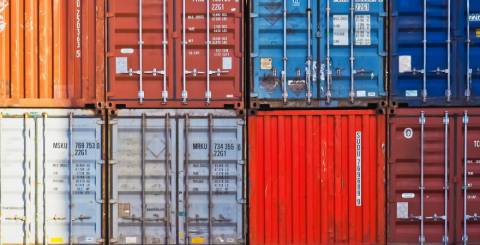How Shipping Containers Have Changed The World

At first glance, the humble shipping container might not look like much: just a simple steel box we pack things into for transportation. Take a closer look, however, and you’ll come to the realization that this seemingly modest box has had a profound effect on our world, becoming an integral part of the modern society we currently live in.
Before the 1950’s maritime shipping used to be very different from what it is today. Loading and unloading of ships used to be done manually by dockworkers. They would individually load onto ships the cargo to be transported (usually a mixed assortment of bags, crates, drums, and barrels) and later unload the vessel at the destination port.
This traditional method of shipping was called “break bulk shipping,” on account of how bulk cargo was split into small batches to make manual loading and offloading of vessels easier. The method was time-consuming – sometimes taking as much time to unload a ship at port as the voyage there did. Loss and damage of goods were also rampant, with so many unconsolidated batches passing through multiple hands. This line of work also carried a significant risk for dockworkers resulting in many workplace injuries and fatalities.
1956: Malcolm McLean starts a revolution
It was in 1956 when American trucking entrepreneur, Malcolm McLean, in his quest to expand his logistics business to maritime transport, came up with the idea of the intermodal shipping container – a shipping unit that could be seamlessly transferred from one mode of transport to another without unpacking its content.
While the idea of transporting stuff in boxes had been tried in previous years, McLean’s containers had a new trick up their sleeves: a connecting and locking mechanism that made stacking, crane-lifting and mounting on flatbeds a lot easier. But still, it wasn’t enough to get industry players excited about the new product.
Wide and global adoption of the intermodal shipping container would not come to be until the 1960s when, during the Vietnam war, McLean got a contract from the U.S. government to set up a container route to Vietnam to supply the troops serving there. Now the revolution in shipping had begun.
Currently containerised cargo accounts for more than 60% of the global maritime trade with 20 million twenty-foot equivalent units (TEUs) in transit at any given moment around the world.
The impact of shipping containers on the world
Since their domination of global maritime transport started in the '60s, shipping containers have had several major impacts on how we trade and move things around on a global scale. Containerisation has changed the world in the following ways:
- Port redesign and mechanisation. With the advent of the shipping container, inner-city ports were rendered redundant with large-scale container terminals located outside city limits being preferred. Dockworkers who manually loaded and unloaded ships also had to give way to cranes which could get the job done a lot quicker and more efficiently.
- Infrastructure Adaptation to containers. It’s not only ports that had to change to accommodate the shipping container; ships, trucks, trains, aircraft, and cranes would also be designed around the standardized shipping container dimensions. Now, most cargo-transport infrastructure is made specifically for handling and transporting cargo containers.
- Seamless intermodal cargo transport. Thanks to the standardisation of the shipping container and the adaptation of global infrastructure to suit these standard dimensions, cargo containers can be moved seamlessly from one mode of transport to the other. This means that goods can be moved from train to ship then to truck without taking them out of the container they originally started out in.
- Cheaper, more efficient shipping. Back in the ’50s, it cost about $ 5.86 per tonne to load a shipping container. Theft, damage, and loss of cargo ate up about 75% of the loading cost. Today, cargo-loading costs are as low as $ 0.16 per tonne, a significant price reduction. Increased efficiency at ports, thanks to the introduction of the cargo container, also means that cargo ships spend less time at port, further reducing costs.
- Large-scale globalisation. With efficiency, predictability and reduced costs in maritime shipping, companies in Australia, the U.S., and Europe have been shifting assembly and manufacturing processes to developing nations where production costs are lower. In return, developed nations concentrate on activities higher up the value chain such as design and research. And in the end, it’s you the consumer who gets the benefit of low-cost high-quality products.
- Supercargo capacity. When loaded to capacity, a standard sized container ship can carry about 13,000 TEUs packed with all sorts of things from motor vehicle components to clothing. Laid end-to-end, the containers would stretch out to about 80 kilometres in length. This huge capacity of container ships and the ports they dock in has seen cross-ocean trade grow exponentially to the mammoth scale it’s currently at.
- Reduced emissions. Because of their large capacity, cargo ships produce significantly less carbon emissions per container (one-third to be precise) compared to what a truck would produce transporting a similar cargo container over a comparable distance. This is excellent news for a planet struggling with a pollution problem.
- Synchronisation of global supply chains. Sea containers have brought about sophistication and synchronisation in the global supply chain. Container units are tagged and tracked electronically throughout their journey with estimated departure and arrival times achieved with near-perfect precision.
- New manufacturing philosophies. The synchronisation and predictability brought about by containerisation has spawned the “just-in-time” manufacturing concept that bypasses warehouses to have components move straight from containers to the production line. This has the effect of lower manufacturing overheads.
- Shipping container architecture. It’s not only in logistics and commerce where containers have had an impact. Their effect has also been felt in the building and construction sector where shipping containers, both new and second-hand, are transformed into buildings and spaces for all sorts of uses from offices to kitchens to shopping malls. The durability, affordability, and versatility of the modular shipping container have made it the ideal construction material for any type of building project. Now shipping container conversions have become so widespread as to be considered mainstream.
Looking at the significant impact the fairly unassuming cargo container has had on our world, it would be an understatement to say that the world would be a much different place without these metal boxes. The invention of the shipping container not only revolutionised how we do business, move cargo, and build; it also had a far-reaching effect on all our lifestyles on a personal level.
So next time a truck hauling a cargo container edges alongside you on the highway, take a moment to appreciate the remarkable changes that that steel box has brought – and all the future possibilities that still lie ahead.
Infographic by Tiger Containers
Similar Articles
Did you know that approximately 7.3 million individuals received disabled worker insurance from Social Security as of April 2024? Beneficiaries can receive monthly payments that are intended to help cover living expenses while they are unable to work.
Discover the benefits of 55+ communities designed for active, engaging lifestyles. Learn how to choose the right fit for your needs, preferences, and budget.
Elevate your community app with key features & functions! Follow our step-by-step guide to enhance user engagement and maximize app potential.



